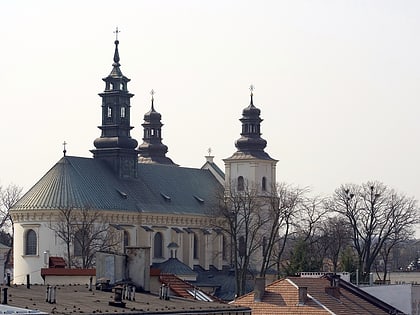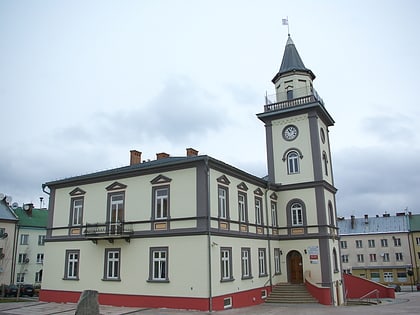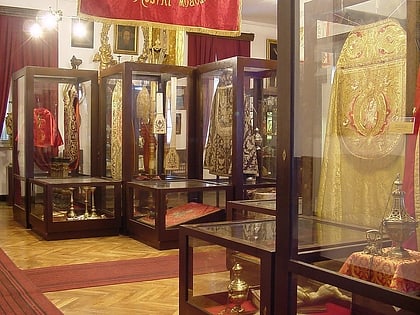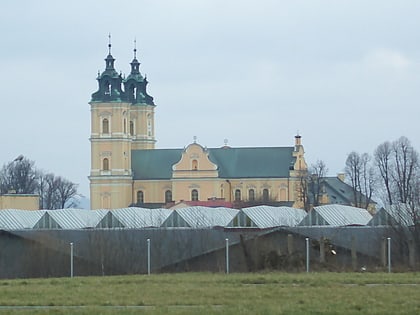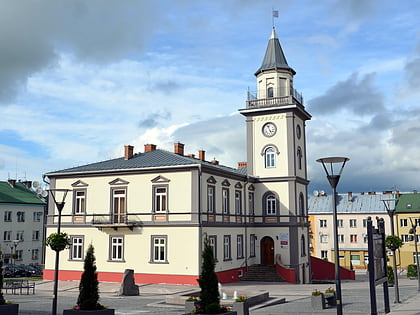Kościół pw. św. Mikołaja i Józefa
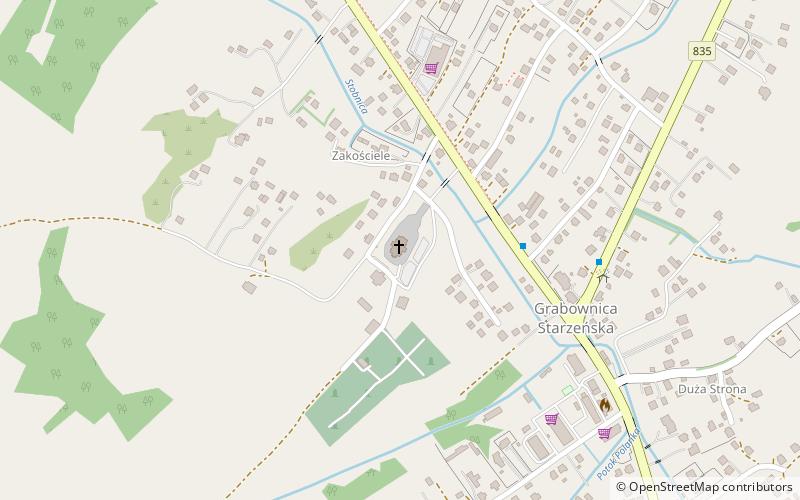

Facts and practical information
Church of St. Nicholas the Bishop and St. Joseph in Grabownica Starzeńska - a neo-Gothic temple in Grabownica Starzeńska.
The plan of the building was made by Wladyslaw Chomiak and Wilhelm Szomek. The building was erected between 1913-1926. The church is on the list of monuments: there are interiors transferred from the eighteenth century church, while the belfry, grave obelisk, church cemetery, "old" parsonage, parochial school and the present organist's house were also entered in the register.
In 1593 a wooden church was erected in Grabownica, which was founded by the then owner of the village, Jerzy Pełka - hunter from Sanok. On June 15, 1624 the Tatars invasion took place, as a result of which the church burned down. In the same year the owner of the village, Hieronim Nagórski, began building a new church, which lasted eight years - until 1631.
This church, although renovated many times, proved to be too small for the parish community, so the construction of a new church began in 1913 and was completely finished in 1926. The old church served the parish until 1920, when the consecration of the new church took place. In 1921, the church was moved to Grabowka, where it received the name of the Blessed Virgin Mary.
The church in Grabowna Starzeńska was built in neo-Gothic style, on a Latin cross plan with arms forming a transept, not oriented. It is made of brick, not plastered, on a foundation of stone blocks. It has a broken, gable roof, covered with copper sheets, with a little bell on it. The church has three naves and a presbytery ended with semicircular apse. The tower, about forty meters high, topped with a cupola with a cross, is located in the front part of the building. The cross and barrel vaults are supported by four main inter-naval pillars. The choir is supported by four pillars. The windows are closed semicircularly. Stained glass windows in two of them, depicting the Holy Family and the Immaculate Conception of the Blessed Virgin Mary, come from the old church. The polychromy in the interior was made in 1954 by Wladyslaw Lisowski.
The monuments of sacred art inside the church, mostly 17th century, were transferred from the old church, and their detailed presentation was based on the Catalogue of Monuments of Art in Poland by M. Kornecki and J. Samek.
The main altar was made in Baroque style, probably in 1633. It was rebuilt twice, namely in 1724 and in 1926 by the sculptor Joseph Lasek from Humniska. This altar is architectural with gates and sculptures of four angels, dating from 1724. In the main field there is a statue of the Sacred Heart of Jesus over which there is a painting depicting St. Nicholas adored by a figure of a bishop, identified with the Ordinary of Przemysl, Henryk Firlej, and by Hieronim Nagórski with his brother Wojciech - the local parish priest - his wife Jadwiga and his sisters. This Baroque painting was painted in 1633 from the foundation of Jadwiga Nagórska, and repainted in 1733 and 1926. The antepedium with woodcarving decoration with floral motives comes from 1716.The side altars by the rood-screen were made at the expense of Wojciech Praysnar - a townsman from Brzozów. They are one-storey high, with finials, pairs of columns and lugs of dry acanthus.
The left altar, gilded, comes from 1720, and its founder was Piotr Górski - the owner of Grabownica at that time. In the middle field there is a late Baroque sculpture of Our Lady of Sorrows, donated by Valentin Sniezinski - parish priest of Humnica, gilded in 1715 at the expense of Stanislaw Rulawski, with rays added in 1718. On the slider there is a Baroque painting of the Annunciation of the Blessed Virgin Mary, contemporary with the altar. Above the main field is a carved bust of God the Father, in the finial are two sculptures of angels, dating from that time. The antepedium comes from 1729. The woodcarving decoration has floral and plant motifs. On the mensa of the altar, there is a late Baroque tabernacle, contemporary with the altar, with a bas-relief of a pelican on the door. In the main field there is a statue of St. Joseph with the Infant Jesus, in the coping - the Assumption of the Blessed Virgin Mary. The antepedium with carved decoration with floral and plant motives was made in 1729 from the foundation of Stefan Krupski - the provost of Sanok.
At the ends of the transept there are side altars: the left one, Baroque in style from the first half of the nineteenth century, has a Baroque painting of St. John of Nepomuk from the eighteenth century in the coping, while the right one, with fragments of the late Renaissance, from the first half of the seventeenth century and coming from the destroyed Capuchin church on St. Michael's Hill in Blizne. In the main field there is a statue of St. Barbara, the patron saint of Grabownice oil workers, in the coping there is a sculpture of St. Anthony from the 17th century.
A special place in the Grabownica church is occupied by a copy of a portrait of Hieronim Nagórski, founder of the seventeenth-century church in Grabownica Starzeńska, with coats of arms: Ostoja, Jelita, Starykoń, Janina and with the letters "HNDN". The inscription on the painting reads: In the year over one thousand six hundred and twenty four the Tartars burnt down the church of that place, So from Nagórzyce Nagórski another one is put up, In honour of God May he reign in Heaven for ever. His name is Hieronymus, his wife Jadwiga, to ask God for them is a special obligation.
Extremely valuable is the Baroque closet in the sacristy, dating from the seventeenth century, with fitted wings from the altar, in which the late Renaissance paintings of St. Sebastian and St. Roch, dating from about 1600, are placed, in which the tradition of panel painting is dying out.
Inside the church there are numerous monuments of sacral art, the most important of which are: a pulpit from the first half of the eighteenth century with a relief of a sheepfold on the sill, rebuilt in 1926 by Jozef Lasek; a baroque baptismal font from 1728, wooden with an openwork cover on which is carved a group of Christ's baptism, and a baroque stone stoup from the seventeenth century.
Subcarpathian
Kościół pw. św. Mikołaja i Józefa – popular in the area (distance from the attraction)
Nearby attractions include: Kościół pw. Świętej Trójcy w Międzybrodziu, Kolegiata Przemienienia Pańskiego, Muzeum Regionalne, Kościół świętych Piotra i Pawła.


